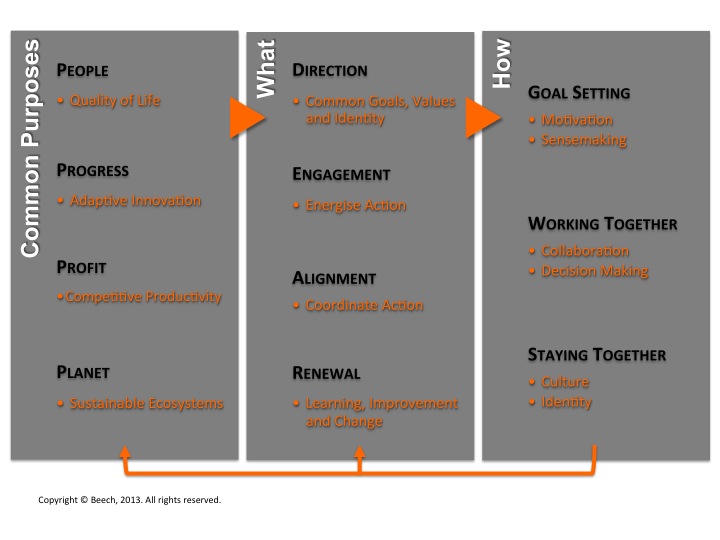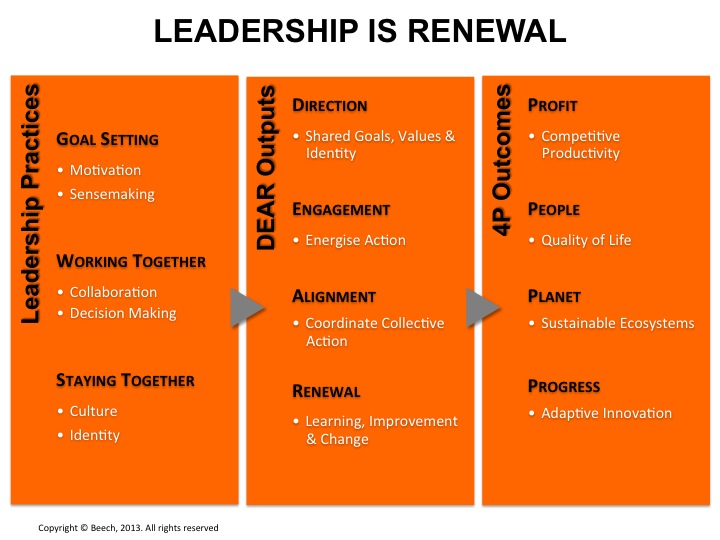Making profits through competitive entrepreneurial activity drives economic progress. Consequently, enabling and promoting economic enterprise is a primary responsibility of corporate governance¹. Moreover, progress by entrepreneurs in implementing new combinations² extends to all aspects of a triple bottom line³: competitive productivity for profit; quality of life for people; and, sustainability of the planet’s resources for the survival and flourishing of species and ecosystems.
However, triple bottom line accounting and related frameworks fail to emphasise the foundations of sustainable prosperity in continuous and competitive entrepreneurship and innovation. Enterprising progress in the lives of individuals and their communities requires adaptive innovation – successful implementation of new combinations – in all aspects of sustainable prosperity. Accordingly an interrelated quadruple bottom line of 4P’s – people, profit, planet, and progress – provides the basis for a more comprehensive framework for developing measures of sustainable prosperity.
Profit is the best index of sustainability we have and entrepreneurship in competitive markets is the least worst option for generating profit and sustainable prosperity. Of course markets are regulated; effective markets require private property rights, legally binding contracts, and equality before the law. Without profit markets are not possible and without markets quality of life is diminished. Decisive issues here are how the operation of markets and the generation and distribution of profit are regulated in relation to their impacts on a quadruple bottom line for sustainable prosperity.
Sustainable prosperity is “a result of sustainable development that enables all human beings to live with their basic needs met, with their dignity acknowledged, and with abundant opportunity to pursue lives of satisfaction and happiness, all without risk of denying others in the present and the future the ability to do the same”⁴. This definition puts human beings at the centre of sustainability. The licence to produce and distribute goods and services at a profit is based on human requirements to consume and experience goods and services for survival and identity.
Competitive survival for individuals, businesses, and communities and sustainable prosperity for an expanding population of over 7bn people requires relentless attention to continuous improvements in cost control, resource use, and conservation, and continuous innovation in products, processes, business models, and institutional arrangements.
In general terms a QBL – quadruple bottom line – for sustainable prosperity can be defined as follows:
SUSTAINABLE PROSPERITY: 4P’s
People – Quality of Life
Quality of life for people, e.g., health, vigour, wellbeing, flourishing.
Profit – Competitive Productivity
Competitive productivity in producing and distributing goods and services for consumption and profit with scarce resources.
Planet – Sustainable Ecosystems
Individual, community, and ecosystems survival across lifespans and generations.
Progress⁵ – Adaptive Innovation
Adaptive innovation – e.g., adaptive learning and change; trial and error risk taking and discovery – in all aspects of people, profit, and planet, and innovations in being innovative⁶.
Rigorous measures of financial operations and competitive economic productivity are well established. A start has been made in recent years on developing measures of sustainable prosperity⁷. The contribution of a QBL perspective is its requirement for explicit attention to entrepreneurial progress – continuous and competitive adaptive innovation – in all aspects of quality of life, competitive productivity, and ecosystems sustainability. In sum, entrepreneurship and innovation drive the progress of sustainable prosperity.
Notes
- Charkham, J. (2005). Keeping better company, 2nd ed. Oxford: Oxford University Press.
- Schumpeter, J.A. (1911/1934). The theory of economic development. London: Transaction Publishers.
- “… the ecological bottom-line: no ecosphere, no economy, no society”, p 147 Wackernagel, M. & Rees, W. (1996). Our ecological footprint. Gabriola Island, BC: New Society Publishers; and Elkington, J. (1997). Cannibals with forks: The triple bottom line of 21st century business. Chichester, UK: Capstone;
- The Worldwatch Institute. (2012). State of the world 2012: Creating sustainable prosperity. Washington, DC: Island Press.
- Strictly, progress is change that survives; and there is a natural desire – not necessarily met – for progress to provide an improvement on previous conditions.
- See, for example, Dodgson, M. & Gann, D. (2010). Innovation: A very short introduction. Oxford: Oxford University Press; Schon, D.A. & Rein, M. (1994). Frame reflection: Towards the resolution of intractable policy controversies. New York: Basic Books.
- See, for example, Global Reporting Initiative (GRI). (2000). Sustainability reporting guidelines on economic, environmental, and social performance. GRI: Boston; Stiglitz, J.E., Sen, A., & Fitoussi, J-P. (2010). Mismeasuring our lives: Why GDP doesn’t add up. London: The New Press; Bilbao-Osario et al (2012). Assessing the sustainable competitiveness of nations. The global competitiveness report 2012-2013. Geneva: World Economic Forum.









